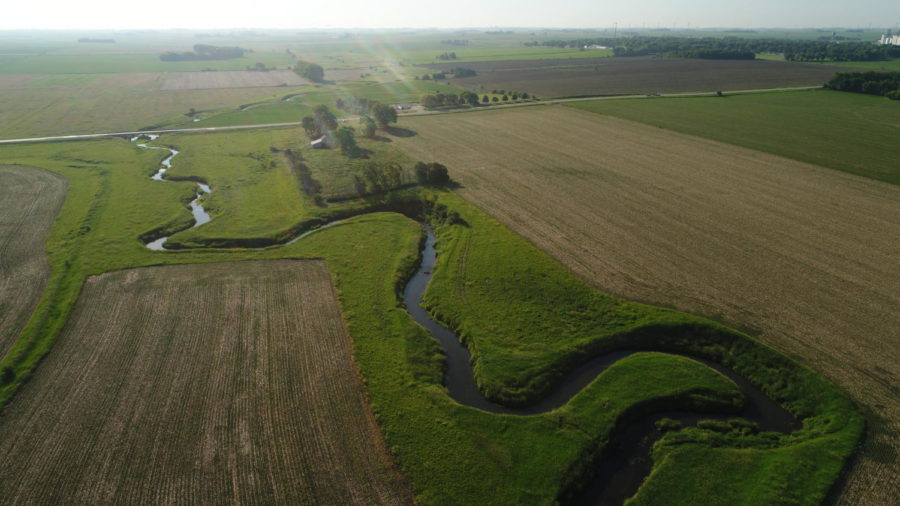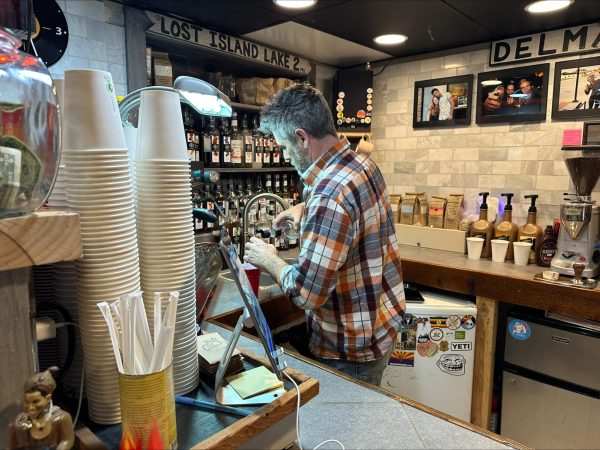‘It’s important to protect the soil’: Erosion costs Iowa millions
Nathan Anderson’s farm in Cherokee County, Iowa.
Andrew Van Nice, a senior in agricultural studies, utilizes cover cropping to maintain soil quality on his 1,300 acre family farm in Blue Grass, Iowa.
Cover cropping is a preventative measure farmers can take by planting a winter crop to help reduce soil erosion and maintain soil quality.
Van Nice said when his grandfather farmed their land, full tillage was the norm. Full tillage results in fractured soil which accelerates surface runoff and soil erosion, according to Iowa State University Extension and Outreach.
Van Nice and his father have taken on the responsibility of adopting better farming practices. Van Nice said taking on these practices was not due to financial reasons or peer pressure but what they felt was right for their farm.
“We have felt that the soil that we have on the farm is not ours; we’re just borrowing it from all generations,” Van Nice said. “So, we feel it’s important to protect the soil that’s there and not let any be lost, so it’s kind of just our own idea that we want to keep it, keep the soil there and keep everything preserved.”
The Van Nice family is in the minority of farmers who choose to use cover cropping, with 3-6% of Iowa farms adopting the conservation method, according to Richard Cruse, a professor of agronomy and the director of the Iowa Waterway Center.
Based on weight, soil is the number one pollutant in Iowa waters. Cruse said that does not mean it is the most serious in terms of impacting health, but it is a challenge because it floods filters and fills reservoirs.
“The phosphorus that’s attached to soil particles–that is by far the dominant part right now–is a major player in water quality impairment problems,” Cruse said.
Cruse said as topsoil erodes, crop yields are reduced. Research has found erosion costs the state of Iowa millions of dollars in productivity, but that impact on yield is coming from the last 150 years of erosion.
“So just to say that today’s farming is having a strong negative impact, especially with the phosphorus in this problem, is probably a little bit of a misnomer,” Cruse said. “But it is wrong to say that farming in Iowa has not had an impact on what is in the streams today.”
Many floodplains in Iowa are filled with sediment that has migrated from farm fields down to the floodplain, Cruse said. A third or more of phosphorus exports in the state is due to eroding streambanks, according to the College of Agricultural and Life Sciences. While this is a natural process, modern land development and farming practices like drainage and stream channelization can accelerate this process.
Cruse said phosphorus and nitrogen are tied to the soil, essentially fertilizing the streams when they end up in surface waters. This contributes to algae blooms and plant growth in water. However, the overgrowth of algae can result in dead zones where aquatic life can no longer survive. The algae not only consumes much of the oxygen in the water, but it also blocks sunlight for plants living beneath the water, according to the Environmental Protection Agency.
Nathan Anderson is the president of Practical Farmers of Iowa and has a farming operation in Cherokee County. The farm is a little over 1,000 acres, and they primarily raise row crop corn and soybeans as well as some hay for a cow-calf herd.
Anderson has also used precision technology and prescription conservation to target native perennial plant areas along streams and rivers at the edge of fields to protect water sources.
Today’s water quality problems due to phosphorus cannot be solely blamed on today’s farmers, Cruse said.
“Erosion is a stepwise process,” Cruse said. “It doesn’t magically pick something up and carry it all the way to the Gulf of Mexico. It may carry partway down the slope and then a storm comes and moves it further, and you eventually get into this floodplain.”
Costs associated with erosion
The erosion that occurred last year has an impact of about 30 cents per acre. Cruse said the effects are greater when it is accumulated year after year; that is where the cost breaches millions of dollars.
Cruse said farmers have told him they can tell where soil erosion is an issue on their land simply based on their yield monitor, but it varies from year to year.
“Good topsoil is a great insurance policy,” Cruse said. “When you have weather problems with production, you want a healthy topsoil.”
Anderson said they occasionally grow winter and spring wheat and cereal rye during the winter. In the last year, Anderson said the drought prevented the cover crop seed from germinating.
On hillsides or hilltops during drought years, Anderson said he can identify when the most productive soil eroded based on the response from his crops.
“We can definitely see some yield decline and some more visual symptoms of stress in that crop,” Anderson said. “For corn, their leaves will curl up when there’s drought stress, for example, so we can see that sooner in those areas of the field relative to areas of the field that still have deeper topsoil.”
Anderson said a cover crop is dependent on rain to serve its purpose. At the same time, the most erosive agent impacting the soil surface is rain.
“The last couple years, especially in northwest Iowa with as dry as we’ve been, our cover crops have still grown, but I would say their level of success has been reduced because we haven’t had as much moisture to help those cover crops grow and do the job that we planted them for to hold nutrients in place,” Anderson said.
Cruse said cover crops can lessen the erosion of soil by intercepting raindrops and capturing excess nutrients.
“When you look straight down and see nothing but green, that is the same thing a raindrop sees,” Cruse said. “So if it hits that canopy, that energy is still absorbed, and we don’t have much erosion.”
If fields are bare from April through May, it is a vulnerable time for crops because of the heavy rainfall.
“This is not about climate change, but our climate models are suggesting we are going to have wetter springs and warmer, drier summers and falls,” Cruse said.
After the development of effective herbicides, Cruse said the use of tilling decreased somewhere between 30-40% on average, depending on the location. In certain areas of the Des Moines Lobe ecoregion, tillage is still heavily practiced, but in the Loess Hills, there tends to be less tillage, Cruse said.
More recently, the decrease in tillage has leveled off. In northern Iowa, wet springs dry more slowly due to colder temperatures. Cruse said this means farmers are more comfortable and have greater success by doing some tilling in the spring.
The most common farming practice in Iowa is a corn and soybean cropping rotation planted by row crops.
“They’re hard on soil depending on how they are managed,” Cruse said. “The intense tillage and constant monoculture, similar cropping without cover crops, with a tillage component is hard on the soil.”
These practices increase susceptibility to erosion when heavy rains or wind occur. Cruse said tillage and gravity also move soil. Cruse often uses the example of filling a pizza pan with half an inch of sand and then drawing lines in it, like when farmers till the land. If the pan gets tipped at a slight slope and the sand is tilled, it moves to the bottom of the pan.
“The same thing happens when you are tilling; gravity works,” Cruse said. “Those practices are somewhat challenging.”
Every fall, Van Nice and his family plant a cover crop to cover the ground throughout the winter and most of the spring. Currently, they have rye and terraces to help maintain their soil.
“We are in some of the steeper ground of the surrounding counties, so we do everything we can to keep soil from washing down the hill and the steepest spots,” Van Nice said.
High crop yields result in a high amount of biomass from corn stalks and leaves. Cruse said no-till, especially for continuous corn, can make managing crop residue a challenge.
“The yields themselves have kind of encouraged some tillage, some destruction of those stalks trying to get them to break down so you have a decent seedbed for the next spring,” Cruse said.
Anderson has been farming full-time since he graduated from Iowa State University with a bachelor’s degree in agronomy. In addition to cover cropping, Anderson said they use no-till and strip-till.
Strip-till combines no-till and full tillage creating narrow strips to serve as planter rows and leaving rows untouched, according to North Dakota State University. Anderson said this minimizes the amount of soil disturbed before planting.
Costs of cover cropping
Farmers who take advantage of cover cropping have to pay for the costs of seeds and planting. In the spring, farmers have to either pay for the herbicides to kill the cover crop, tillage or picking the crop.
The Van Nices practice no-till, so their main cost is paying for the seed they plant.
“It’s kind of just the labor costs that we have to consume ourselves, so it is a fairly low-cost operation,” Van Nice said. “We also believe that with no-till you don’t have the fuel and labor cost of doing tillage, so that can kind of offset some of the costs of having to do cover crops and other seeding.
Van Nice said it is always a battle between no-till and conventional tillage farms, and regardless in most situations, it is a personal preference.
“It’s hard to adapt to changing times, especially for farmers who have been doing things for several tens of years, hundreds of years,” Van Nice said. “It’s just difficult for people to change, so people need to understand that change is going to be battled differently with different people.”
Anderson said if there are cover crops pulling in moisture in a dry year, that moisture might not be immediately available to the primary crop.
“We have had to control our cover crop earlier in the spring just to conserve that moisture for the primary crop,” Anderson said.
There can be risks associated with cover croppings such as mismanagement and difficulty getting nitrogen to corn crops due to the cover crops. These challenges threaten the yield of primary crops.
Anderson said it is a unique privilege to be able to farm family-owned land because much of the land in Iowa is rented out. Farming rented land does not have as great of an incentive to implement conservation practices because of short contracts and demand for maximum yield. Because they have a family farm, Anderson said they are able to see the results in soil quality over time.
“On our farm, we have a privilege and a responsibility at the same time that we can invest in practices that have a return over a longer time frame,” Anderson said. “Yes, we still need to make money every year, but we are not reliant on only having one, two or three years of access to a particular field.”
Your donation will support the student journalists of the Iowa State Daily. Your contribution will allow us to purchase equipment, send our student journalists to conferences and off-set their cost of living so they can continue to do best-in-the-nation work at the Iowa State Daily.















